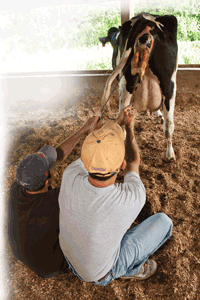 Two clean, white tips of hooves are peaking out of the rear end of your 4-H heifer. Soon, a pink nose starts to come. It is her first calf, and you bred her to that sire known for big show calves. While this may have seemed like a good breeding decision shortly after you placed third in the class at county fair because your heifer was "not growthy enough," suddenly the thought of a difficult calving is stressing you out.
Two clean, white tips of hooves are peaking out of the rear end of your 4-H heifer. Soon, a pink nose starts to come. It is her first calf, and you bred her to that sire known for big show calves. While this may have seemed like a good breeding decision shortly after you placed third in the class at county fair because your heifer was "not growthy enough," suddenly the thought of a difficult calving is stressing you out.A 2007 National Animal Health Monitoring Study (NAHMS) published in 2009 detailed calving intervention on U.S. dairies. After all, calving difficulty - or dystocia - costs the U.S. dairy and beef industries more than $400 million annually. While 69 percent of heifers and just over 79 percent of cows needed no assistance in calving, we must keep ourselves informed on when and how to lend a helping hand to each and every cow that calves on our farm because of its significant impact on the health and productivity of cow and calf.
It simply isn't time efficient, or feasible, to expect calving pens on every dairy to be monitored 24 hours a day. According to calving experts at Colorado State University, it is recommended to check calving pens every one to two hours and once every 30 minutes once stage two of calving has begun.
Knowing when to assist with labor starts with knowing a little more about the labor process itself. Labor can be classified into three stages conveniently known as stage one, two, and three.
Stage one
Duration: Two to six hours.
Characteristics:
- Visible indicators of labor may be few, yet more evident in first-calf heifers.
- Pastured cows seek an isolated location.
- Vaginal discharges will become more liquid, and the cervical plug will be expelled. The first water sac breaks during this stage.
- Occasional kicks at the belly and swishing or wringing of the tail.
Each time the uterus contracts, you can bet that the cow feels a slight, sharp pain which is causing her uneasiness. With each of these contractions, the cervix is progressively dilating.
Stage two
Duration: 30 minutes to four hours, but assistance is suggested before two hours.
Characteristics:
- Fully dilated cervix.
- Second water sac and fetal parts enter the birth canal.
- Uterine contractions intensify, each followed by a short rest period.
- Cows may lie down because of pressure being applied to the birth canal and the pains of intensifying contractions.
- Head forced through birth canal followed by a short rest.
- Shoulders, chest, hips, and legs exit.
Stage three
Duration: 8 to 12 hours postdelivery
Characteristics:
• Fetal membranes are expelled.
When do I help?
Once you can identify the three stages of labor and their expected length, you can begin to make decisions as to when assistance is needed. Stage one of labor usually lasts two to six hours so, if progression into stage two is not noticed, it might be time to start taking precautions. Milk fever (low blood calcium), uterine torsion, or a calf in breech position (see the April 10 issue for more about calving positions) can all prevent cows from progressing through the labor process and could be coming into play in stage one of labor.
In stage two, if the water sac has been visible for two hours and you have not seen any progression (the cow is not trying), intervention could be needed. Also, if the cow has been trying for over 30 minutes and making no progress, if the cow has quit trying for more than a 15- to 20-minute period of time, if the cow or calf is showing signs of stress or fatigue, or if you suspect the calf is in an abnormal presentation, intervention is likely needed.
If these described indications have led you to believe that it is time for some serious intervention, you should first palpate the calf. This may take some hands-on experience so find someone familiar with palpating during calving to teach you. Palpating is necessary to determine if the calf is still alive and if it can be delivered through the birth canal. It consists of using your hand and arm to feel exactly where the calf is at in the birth canal and how it is positioned. Cleanliness and gentleness are very important throughout the calving process but even more important during palpation.
After palpation, if you find that the birth canal is abnormal, it is time for some professional help. If the calf's head is too large to fit through the birth canal, don't force it.
In stage three, the fetal membranes (placentas) are expelled. When cows do expel the membranes, it is typically known as "cleaning" on many farms. If this hasn't happened within 12 hours after calving, you might need to assist. If placentas are retained, don't remove them manually as it may be dangerous to the cow's future reproductive performance. Now is the time to contact your veterinarian. He can help you develop a treatment protocol for retained placentas.
 Gain experience
Gain experienceIf you're the only one helping in the calving pen, it can be difficult to decide what to do next with a cow that just isn't calving. If you cannot assess the calving problem, you know what you are dealing with but don't know how to correct it, or if you have been trying to correct the problem for 30 minutes and have not made any progress, call for help from a parent, sibling, veterinarian, or someone else with experience in calving assistance. Gaining experience in the calving pen is a valuable skill. Make sure all farm personnel who work in this area know guidelines for intervention and why these guidelines are in place.
The next article in this series of two about calving will focus on abnormal calf positions, correction, and pulling calves.
100325_226











